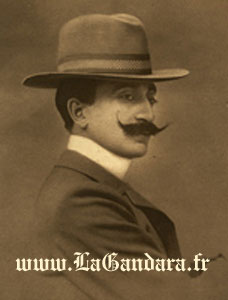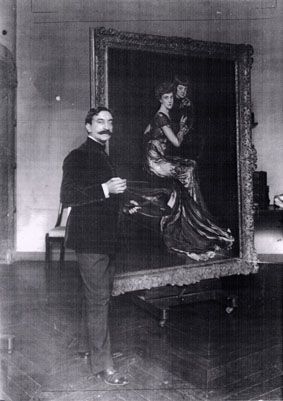Antonio
de la Gandara
(1861-1917)
French
portrait painter
A
prominent Parisian
artist during La Belle Epoque, Antonio de la Gandara established a
lucrative
clientele among the wealthy elite of the city. Almost strictly a
portrait
artist who worked mostly in oils and pastels, though he also executed
drawings
in charcoal and pencil.
He
was a big fan
of Whistler,
and often (like his mentor) isolates his sitters against a neutral
background,
thus endowing them with a striking and often mysterious quality.
Paintings
such
as Mme
Sarah Bernhardt (1892), Comte
Robert de Montesquiou (c. 1892) and Mme
Gautreau in (1898) would cement his reputation as a painter of the
highest order in the elite. His work was widely acclaimed by the
critics
and La Plume devoted a special issue to him on 15th April 1901.
He
is often put
in the company of Boldini, Helleu,
Tissot, and Jacques-Emile
Blanche.
At
the age of fourteen
he entered the Ecole
des Beaux-Arts (1878) and studied with Jean-Léon
Gérôme
and Cabanel from 1876 to 1881 -- two of the preeminent teachers at the
time. The following year (1882) he made his début at the Salon
of
the Société des Artistes Français with a portrait
of Melle Dufresne. In the 1884 Salon (the same year as John
Singer
Sargent's Madame
X) he received an honorable mention and in the Paris World's Fair
of
1889 a bronze medal. Throughout the '90s, he reached the height of his
critical success, showing works at the Salons of the
Société
Nationale des Beaux-Arts, and then from 1892 at the Salon de la
Société
Nationale and at the gallery of Durand-Ruel.
It
would be at
the 1900 Paris World Fair, when La Gandara showed his earlier painting
of Mme Sarah Bernhardt (1892) that he would be awarded the silver
medal,
made Chevalier of the Legion
of Honor and a member of the jury of the Champ de Mars.
The
Masters he
was often compared to by his contemporaries were Velasquez,
Gainsborough,
and of course, his friend Whistler.
When
he painted
the incomparable Comte
Robert de Montesquiou (whom was also his friend and a source of
many
referrals for a time) it was around the same period Whistler painted
Montesquiou
in Paris -- Whistler's
last large portrait (1892). It's revealing of his friendship that
Whistler
used La Gandara's studio at de rue Monsieur-le-Prince for his portrait.
Rumour
had it that
La Gandara had an extended affair with Madame Gautreau after he painted
her in early 1898 -- she was by then thirty-nine years old.
In
1905 he painted
a Portrait Of Romaine
Brooks a prominent member of the American artistic community in
Paris near the beginning of her fame and popularity. The painting was
widely
known and reproduced in Les Arts (1919)
La
Gandara, the
father of three daughters, married twice, first to Anne
Catherine Wilms, second to Charlotte
Saint-André (1909).
From: "The Eldorado of the
Portrait Painter" Munsey's Magazine New York - signed by Charles H.
Caffin.
[Unfortunately, I do not have the date
(1904 ??? the portrait of Mrs. Burke-Roche was first exhibited in 1897)
or issue number.]
A few years ago an exhibition was held in New York of
portraits by Antonio de la Gandara, a Spaniard who lives in Paris.
Among the pictures was a portrait of Mrs. Burke-Roche. The treatment of
a full-sized standing figure in a narrow canvass, originally derived
from Velasquez, was made popular by Whistler, and it is the latter's
portraits which Gandara's recall. This need not imply that the Spaniard
has been a copyist of the older artist, but only that he sought for
similar things through somewhat similar means. And the thing sought by
both is the very antithesis of what Zorn and Sargent seek.
By comparison, the
latter painters are intent upon the obvious; while Gandara, like
Whistler, aims at subtler quality which pervades the thing seen, as
fragrance clings around the flower. I think a study even of the
reproduction of this portrait makes the difference clear. It exhibits a
certain mystery; piques our imagination, and does not wholly satisfy
it. It is very stimulating to have a man's thigh represented, as in
Cleveland portrait, with such actuality that one feels one could pinch
it and find it solidly elastic. Sargent's portraits, with an abundance
of variety, suggest a corresponding enjoyment of the appearance of
things; but it is quite possible to grow weary of obviousness; to
realize that what is most interesting in man and woman is neither their
clothes nor what is visible on the surface. Then it is that the man who
has imagination enough to feel that there is allurement in what is not
appreciable to sight and touch, attracts us. Gandara is one of these.
In his love of the
long sweep of line, such as Velasquez drew, he may have taken certain
liberties with the neck of this lady; but, if so, it has been to
increase our enjoyment, as it did his, in - shall I call it ?- the
vigorous languor of this tall, flower-like form, clipped so closely by
its white stain costume. The portrait has a distinction, not merely of
technical style, but of personality. Further, it has what the French
call diablerie; not the wanton kind, but that unexpectedness and
flavour, appreciable yet evasive, which envelopes a beautiful woman.
From: Xavier
Mathieu
<xavi er.ma
thieu@wanadoo.fr>
Date: Sat, 26 Jul 2003
Hi from France,
My Great Uncle
Antonio de la Gandara
was a famous portrait painter from 1882 to 1917 when he died. I'm doing
the same as you are doing with Sargent whom he knew. They shared the
same
model mme X
alias
Mme Gautreau. He attended the exhibition of his painting in the US
in NY and Boston in August of 1898 where he met Sargent. I'm looking
for
any information about his other works which are in the US or elsewhere
such as its portraits executed of Samule Montgomery Roosevelt or a
quantity
of his oils sold or acquired on this side of the Atlantic.
If you could help
me I will appreciate
regards
Date: March 22,
2004
I'm currently
working with the French
postal authorities to bring about a stamp dedicated to Antonio de La
Gandara.
I'll keep you informed.
Date: Sep 27,
2005
For years,
the Antonio de La Gandara family has been active in promoting his
memory and we finally have a website dedicated to him.

www.LaGandara.fr
Note:
A very special
thanks to Xavier Mathieu,
a friend of
the
JSS Gallery, for help with images and information.
|


